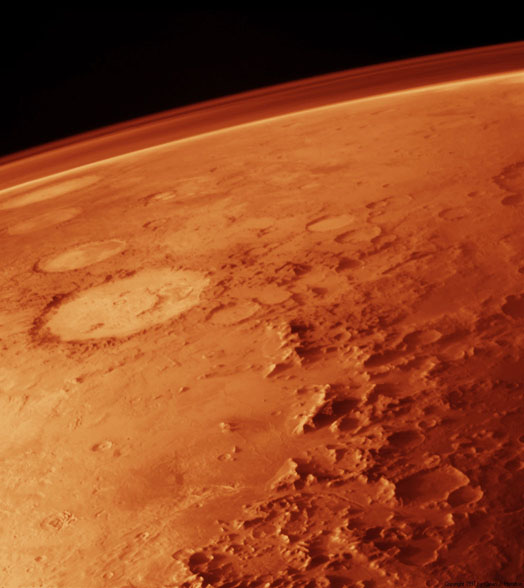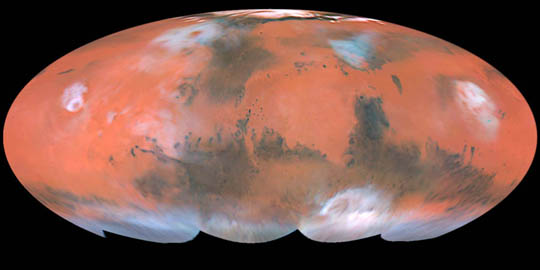Atmospheric
Circulation
|

|
The similarity of Marsís rotation period, axial tilt, and
atmospheric transparency to Earthís suggests a valuable parallel to our
experience with terrestrial meteorology, but certain features unique to Mars
lead to novel departures from familiar behavior. First, the main atmospheric gas
on Mars condenses on the surface, leading to large variations in surface
pressure. Second, the enormous thermal inertia of Earthís ocean and the
massive transport of latent heat by both oceanic circulation and evaporation of
ocean water are not present on Mars to moderate day-night temperature variations
and latitude-dependent temperature gradients. Also, the eccentricity of Marsí
orbit causes "seasonal" temperature variations that heat and cool the
entire planet in concert.
Temperature mapping reveal the driving force behind
planetary-scale winds, also shows that the surface has an extremely small
thermal inertia, requiring the presence of a fine-grained, poorly conducting
dust with a very low gas pressure. The surface temperature therefore responds
quickly to changes in insolation (irradiation by the Sun). |
Circumstances are different when the atmospheric dust content
is high. Dust is always a factor on Mars; even in the absence of dust storms.
Absorption and scattering of sunlight is never truly negligible and is sometimes
a dominant effect. Absorption of sunlight by dust can lead to formation of a
strong inversion layer (a warm layer well above the ground that inhibits
convection from below), which not only affects the daytime vertical motions and
limits the daytime solar heating rate, but also radiates heat to the ground at
night, further diminishing the day-night temperature range. Dust storms also
dramatically warm the poles by the same mechanism.
The general (planetary-scale) circulation of the atmosphere is
characterized by the average zonal (east-west) wind speeds, the average
meridional (north-south) motions, near-stationary wave structures, and
seasonally varying features due to traveling waves. Small-scale processes are
also important, as is the rapid inflation and deflation of the atmosphere during
the diurnal cycle. This phenomenon of atmospheric tides is exacerbated by the
rapid radiative response of the atmosphere.
The Martian atmosphere exhibits a wide range of dynamical
behavior that depends on the dust content of the atmosphere. The dynamics of the
rise, maintenance, and decay of giant dust storms are poorly understood,
although much interesting work is in progress. One intriguing factor is an
apparently chaotic factor governing the onset of severe dust storms: very
similar seasonal and meteorological conditions will generate severe dust storms
in some years, transient storms in others, and no storms at all in others. It is
likely that the process of storm growth is highly nonlinear and sensitive to
rapid divergence in response to extremely small differences in initial
conditions. This behavior may be deeply chaotic in the mathematical sense,
subject only to statistical description over time scales longer than a few days.

A
GLOBAL MAP OF MARS
The
four hemispheric views shown above have been combined into a
full-color
global map (called a Mollweide projection), showing the
regions
of Mars imaged by the Hubble telescope during the planet's
closest
approach to Earth. Latitudes below about 60 degrees south were
not
viewed by the telescope because the planet's north pole was tilted
towards
Earth during this time. This image is a composite of pictures
taken
with three filters: blues (410 nanometers), green (502
nanometers),
and red (673 nanometers). The Hubble telescope's resolution
is
12 miles per pixel (20 kilometers per pixel) near the Martian
equator.
 Atmospheric
Composition
Atmospheric
Composition
 Home
Home

